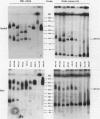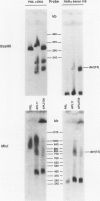Abstract
Acute promyelocytic leukemia (APL) is characterized cytogenetically by a balanced reciprocal chromosomal translocation t(15;17) (q22;q21). This translocation involves the retinoic acid receptor-alpha (RAR-alpha) on chromosome 17 and the promyelocytic leukemia locus (PML) on chromosome 15 and results in the transcription of novel fusion messenger RNAs. In this study, pulsed-field gel electrophoresis (PFGE) was applied to the detection of the t(15;17) translocation in twenty-six clinical specimens cytologically diagnosed by French-American-British criteria as APL. This technique could readily be applied to both fresh and nonviably frozen tumor samples. In 24 of 26 samples, rearrangements of the PML and RAR-alpha, loci could be detected by Southern blotting after digestion with MluI and BssHII. Furthermore, co-migration of the rearranged fragments, detected by hybridization to probes for the PML and RAR-alpha genes, demonstrated that these loci were juxtaposed. The translocation was detected in specimens at the time of initial diagnosis, on differentiation therapy with retinoic acid and at the time of relapse. The diagnostic accuracy was compared to cytogenetics and the reverse transcriptase-polymerase chain reaction for the novel PML-RAR-alpha fusion transcript. The samples from two patients were negative by all three diagnostic methods, and both of these patients failed to respond to all-trans retinoic acid. In the other 24 APL samples, cytogenetics was positive in only 76.9% of the cases, whereas both reverse transcriptase-polymerase chain reaction and PFGE methods detected the translocation in 100% of the cases. Thus, PFGE can readily detect the t(15;17) translocation in both viable and nonviable clinical specimens and can improve the diagnostic accuracy of morphology and cytogenetics in APL. In contrast to conventional electrophoresis based on rearrangement of RAR-alpha, the ability to demonstrate directly co-migration of the PML and RAR-alpha loci enables this method to distinguish the t(15;17) translocation from variant translocations such as the t(11;15). Because PFGE can be performed on nonviable, frozen tumor samples, it could be diagnostically useful in APL when the RNA-based reverse transcriptase-polymerase chain reaction cannot be performed.
Full text
PDF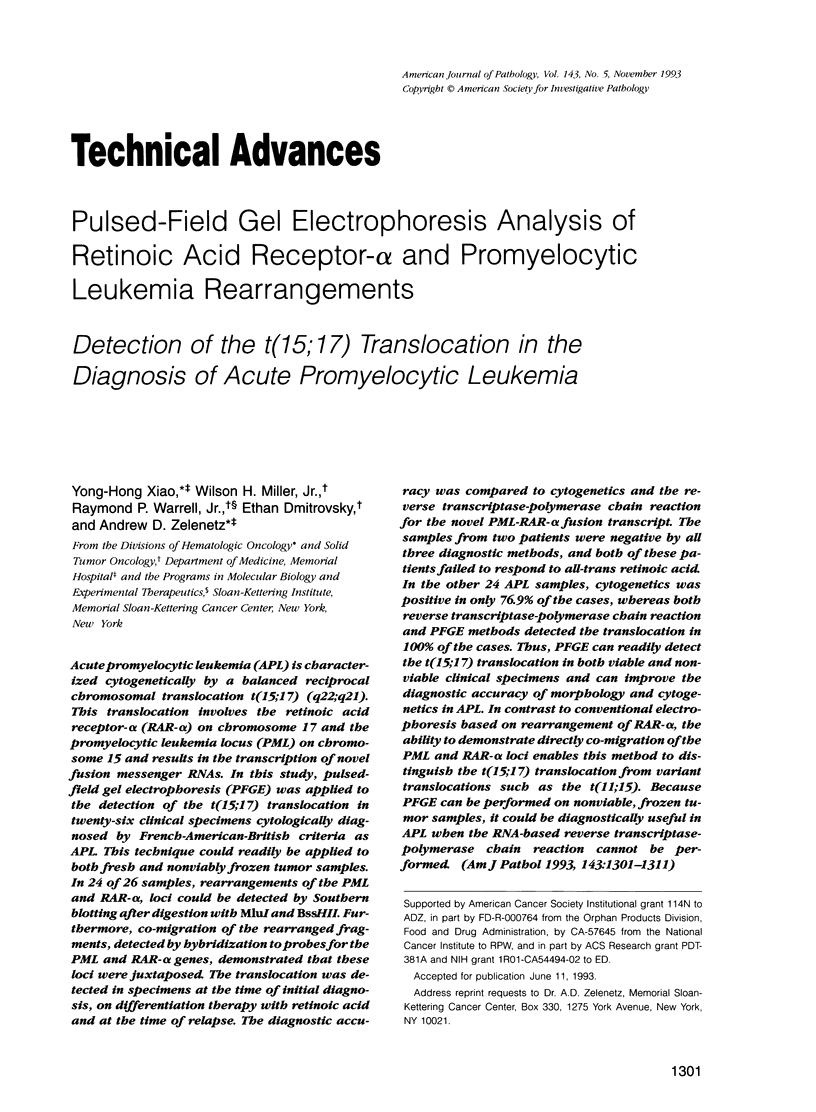
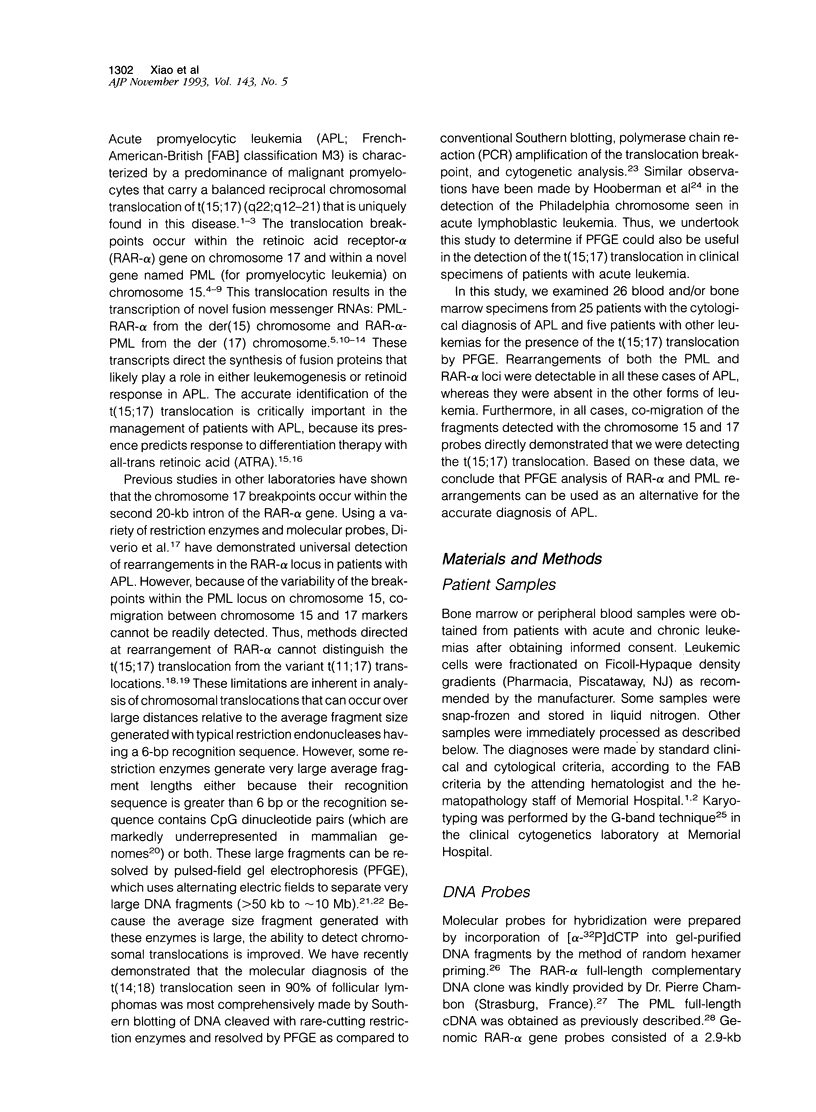
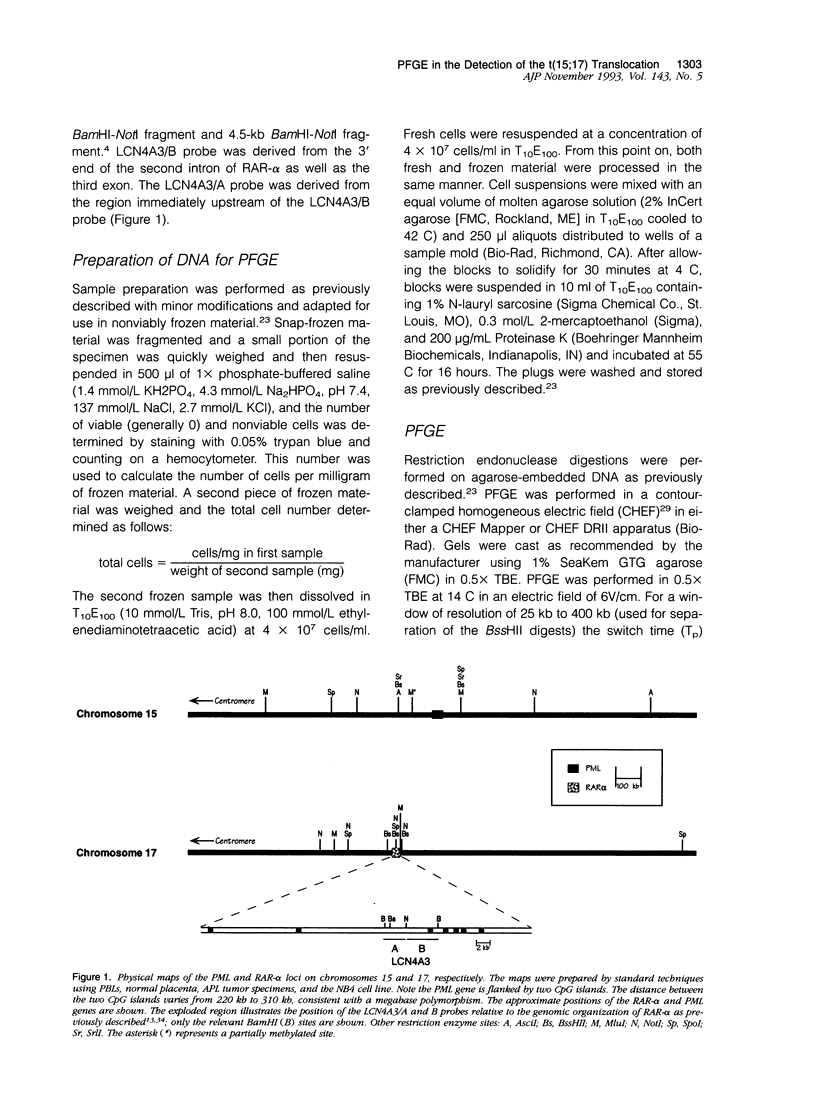
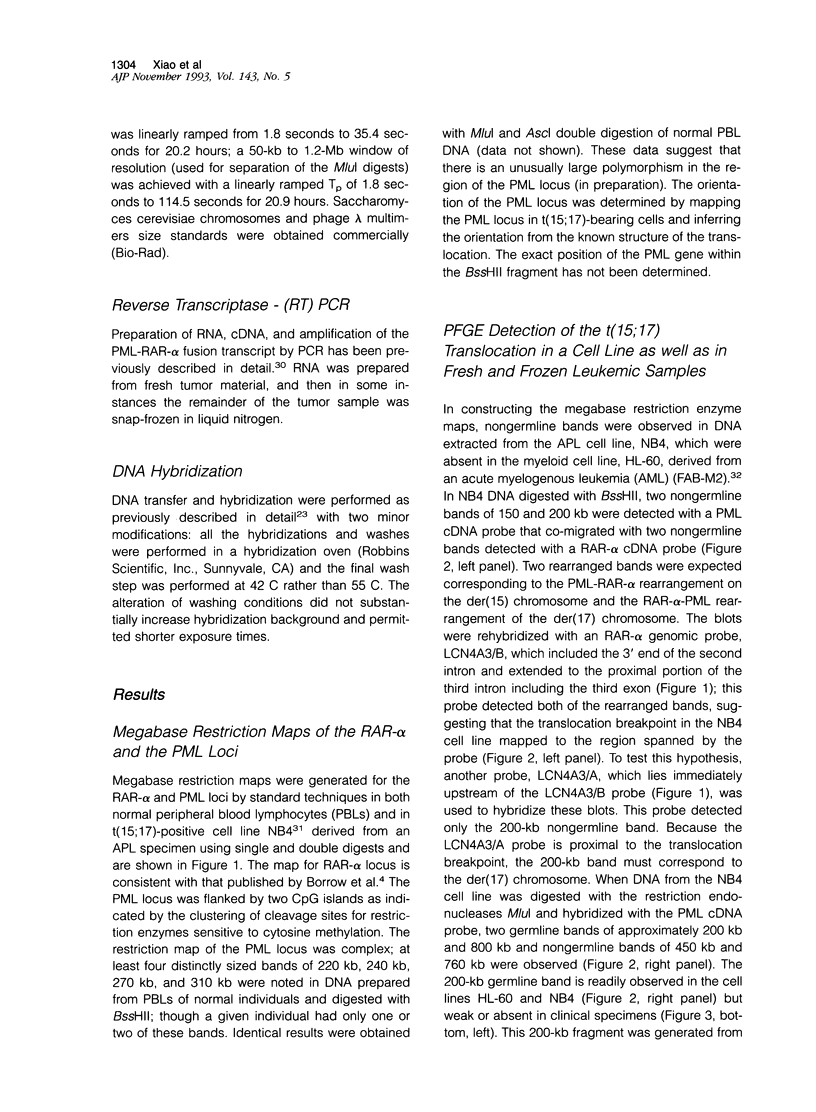
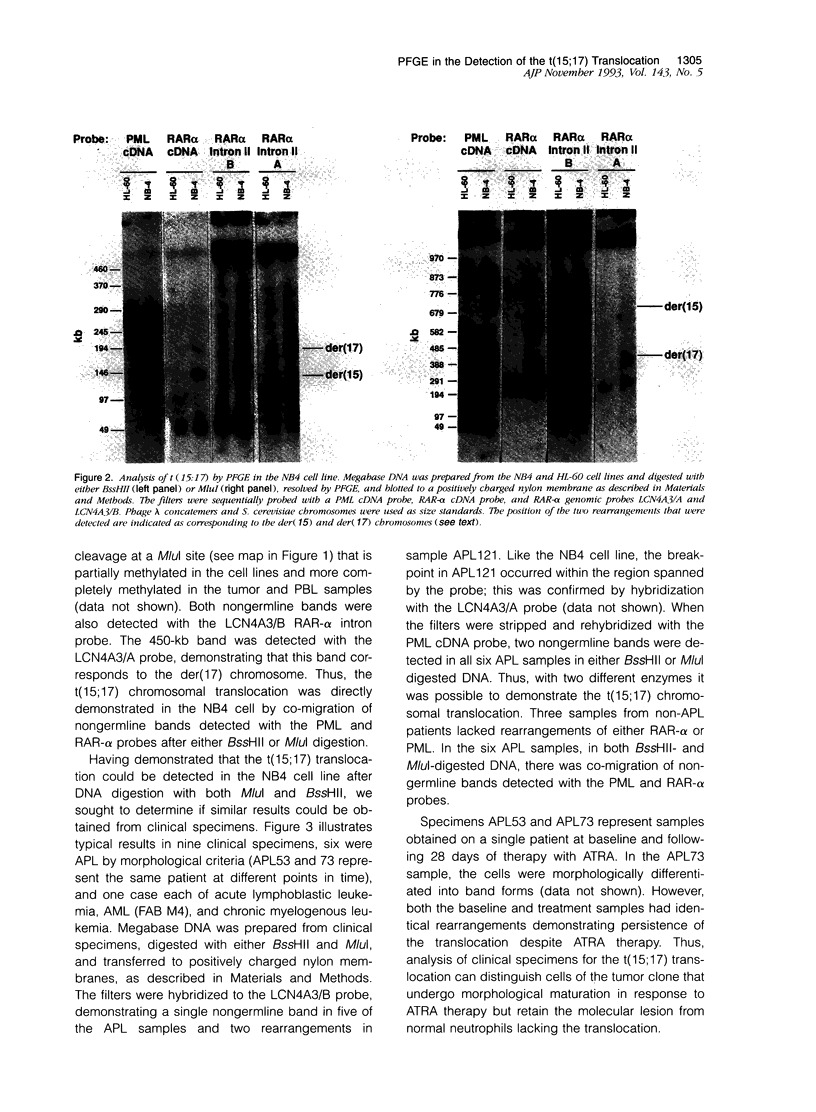


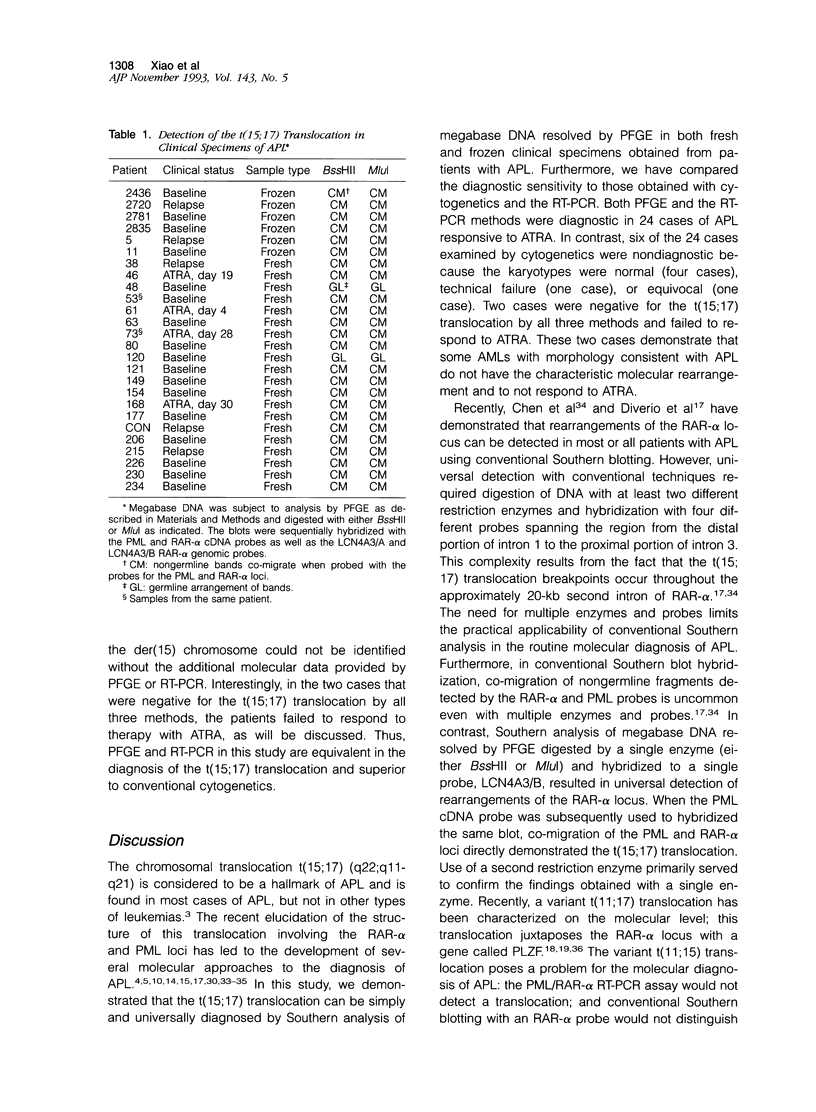
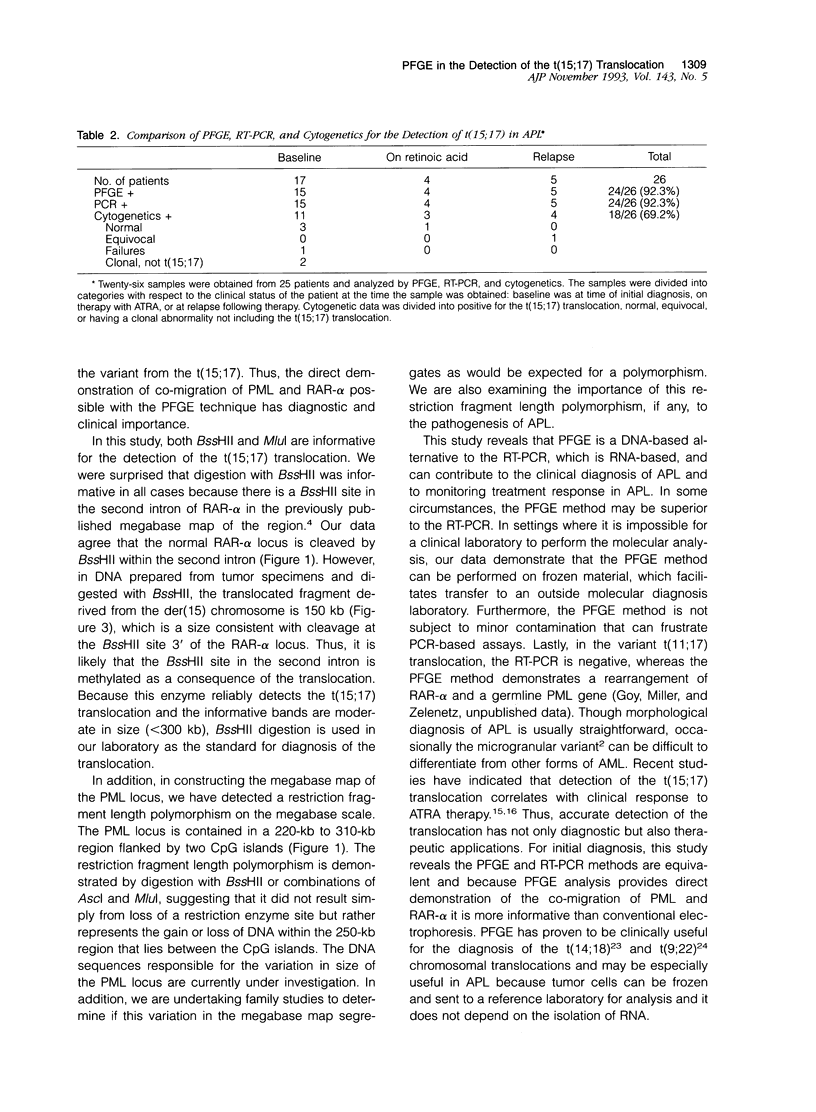
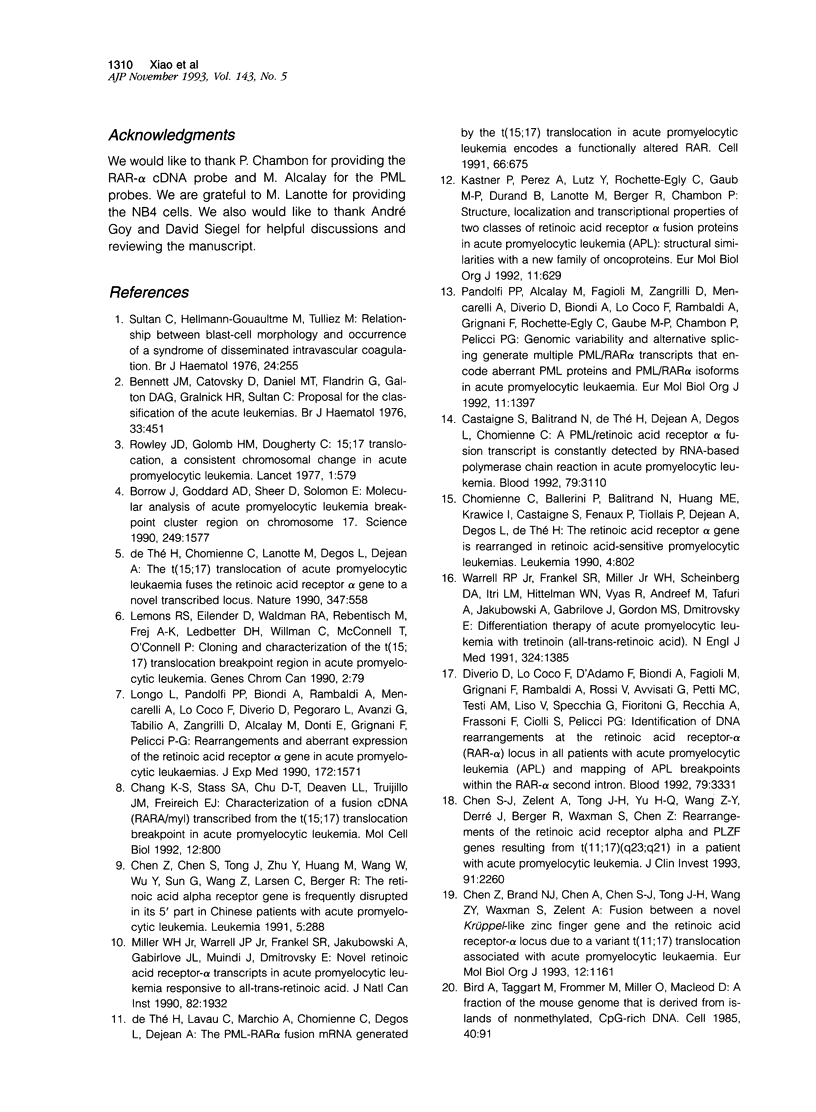
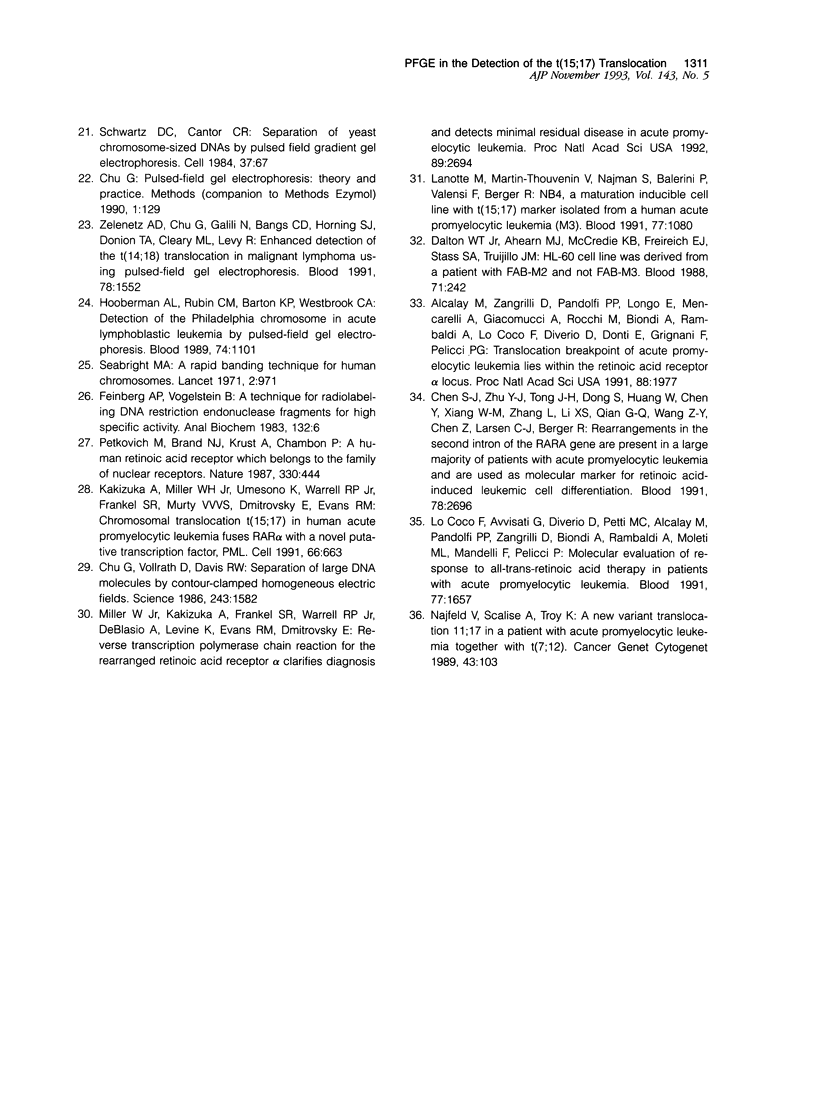
Images in this article
Selected References
These references are in PubMed. This may not be the complete list of references from this article.
- Alcalay M., Zangrilli D., Pandolfi P. P., Longo L., Mencarelli A., Giacomucci A., Rocchi M., Biondi A., Rambaldi A., Lo Coco F. Translocation breakpoint of acute promyelocytic leukemia lies within the retinoic acid receptor alpha locus. Proc Natl Acad Sci U S A. 1991 Mar 1;88(5):1977–1981. doi: 10.1073/pnas.88.5.1977. [DOI] [PMC free article] [PubMed] [Google Scholar]
- Bennett J. M., Catovsky D., Daniel M. T., Flandrin G., Galton D. A., Gralnick H. R., Sultan C. Proposals for the classification of the acute leukaemias. French-American-British (FAB) co-operative group. Br J Haematol. 1976 Aug;33(4):451–458. doi: 10.1111/j.1365-2141.1976.tb03563.x. [DOI] [PubMed] [Google Scholar]
- Bird A., Taggart M., Frommer M., Miller O. J., Macleod D. A fraction of the mouse genome that is derived from islands of nonmethylated, CpG-rich DNA. Cell. 1985 Jan;40(1):91–99. doi: 10.1016/0092-8674(85)90312-5. [DOI] [PubMed] [Google Scholar]
- Borrow J., Goddard A. D., Sheer D., Solomon E. Molecular analysis of acute promyelocytic leukemia breakpoint cluster region on chromosome 17. Science. 1990 Sep 28;249(4976):1577–1580. doi: 10.1126/science.2218500. [DOI] [PubMed] [Google Scholar]
- Chang K. S., Stass S. A., Chu D. T., Deaven L. L., Trujillo J. M., Freireich E. J. Characterization of a fusion cDNA (RARA/myl) transcribed from the t(15;17) translocation breakpoint in acute promyelocytic leukemia. Mol Cell Biol. 1992 Feb;12(2):800–810. doi: 10.1128/mcb.12.2.800. [DOI] [PMC free article] [PubMed] [Google Scholar]
- Chen S. J., Zelent A., Tong J. H., Yu H. Q., Wang Z. Y., Derré J., Berger R., Waxman S., Chen Z. Rearrangements of the retinoic acid receptor alpha and promyelocytic leukemia zinc finger genes resulting from t(11;17)(q23;q21) in a patient with acute promyelocytic leukemia. J Clin Invest. 1993 May;91(5):2260–2267. doi: 10.1172/JCI116453. [DOI] [PMC free article] [PubMed] [Google Scholar]
- Chen S. J., Zhu Y. J., Tong J. H., Dong S., Huang W., Chen Y., Xiang W. M., Zhang L., Li X. S., Qian G. Q. Rearrangements in the second intron of the RARA gene are present in a large majority of patients with acute promyelocytic leukemia and are used as molecular marker for retinoic acid-induced leukemic cell differentiation. Blood. 1991 Nov 15;78(10):2696–2701. [PubMed] [Google Scholar]
- Chen Z., Brand N. J., Chen A., Chen S. J., Tong J. H., Wang Z. Y., Waxman S., Zelent A. Fusion between a novel Krüppel-like zinc finger gene and the retinoic acid receptor-alpha locus due to a variant t(11;17) translocation associated with acute promyelocytic leukaemia. EMBO J. 1993 Mar;12(3):1161–1167. doi: 10.1002/j.1460-2075.1993.tb05757.x. [DOI] [PMC free article] [PubMed] [Google Scholar]
- Chen Z., Chen S. J., Tong J. H., Zhu Y. J., Huang M. E., Wang W. C., Wu Y., Sun G. L., Wang Z. Y., Larsen C. J. The retinoic acid alpha receptor gene is frequently disrupted in its 5' part in Chinese patients with acute promyelocytic leukemia. Leukemia. 1991 Apr;5(4):288–292. [PubMed] [Google Scholar]
- Chomienne C., Ballerini P., Balitrand N., Huang M. E., Krawice I., Castaigne S., Fenaux P., Tiollais P., Dejean A., Degos L. The retinoic acid receptor alpha gene is rearranged in retinoic acid-sensitive promyelocytic leukemias. Leukemia. 1990 Dec;4(12):802–807. [PubMed] [Google Scholar]
- Chu G., Vollrath D., Davis R. W. Separation of large DNA molecules by contour-clamped homogeneous electric fields. Science. 1986 Dec 19;234(4783):1582–1585. doi: 10.1126/science.3538420. [DOI] [PubMed] [Google Scholar]
- Dalton W. T., Jr, Ahearn M. J., McCredie K. B., Freireich E. J., Stass S. A., Trujillo J. M. HL-60 cell line was derived from a patient with FAB-M2 and not FAB-M3. Blood. 1988 Jan;71(1):242–247. [PubMed] [Google Scholar]
- Diverio D., Lo Coco F., D'Adamo F., Biondi A., Fagioli M., Grignani F., Rambaldi A., Rossi V., Avvisati G., Petti M. C. Identification of DNA rearrangements at the retinoic acid receptor-alpha (RAR-alpha) locus in all patients with acute promyelocytic leukemia (APL) and mapping of APL breakpoints within the RAR-alpha second intron. Italian Cooperative Study Group "GIMEMA". Blood. 1992 Jun 15;79(12):3331–3336. [PubMed] [Google Scholar]
- Feinberg A. P., Vogelstein B. A technique for radiolabeling DNA restriction endonuclease fragments to high specific activity. Anal Biochem. 1983 Jul 1;132(1):6–13. doi: 10.1016/0003-2697(83)90418-9. [DOI] [PubMed] [Google Scholar]
- Hooberman A. L., Rubin C. M., Barton K. P., Westbrook C. A. Detection of the Philadelphia chromosome in acute lymphoblastic leukemia by pulsed-field gel electrophoresis. Blood. 1989 Aug 15;74(3):1101–1107. [PubMed] [Google Scholar]
- Kakizuka A., Miller W. H., Jr, Umesono K., Warrell R. P., Jr, Frankel S. R., Murty V. V., Dmitrovsky E., Evans R. M. Chromosomal translocation t(15;17) in human acute promyelocytic leukemia fuses RAR alpha with a novel putative transcription factor, PML. Cell. 1991 Aug 23;66(4):663–674. doi: 10.1016/0092-8674(91)90112-c. [DOI] [PubMed] [Google Scholar]
- Kastner P., Perez A., Lutz Y., Rochette-Egly C., Gaub M. P., Durand B., Lanotte M., Berger R., Chambon P. Structure, localization and transcriptional properties of two classes of retinoic acid receptor alpha fusion proteins in acute promyelocytic leukemia (APL): structural similarities with a new family of oncoproteins. EMBO J. 1992 Feb;11(2):629–642. doi: 10.1002/j.1460-2075.1992.tb05095.x. [DOI] [PMC free article] [PubMed] [Google Scholar]
- Lanotte M., Martin-Thouvenin V., Najman S., Balerini P., Valensi F., Berger R. NB4, a maturation inducible cell line with t(15;17) marker isolated from a human acute promyelocytic leukemia (M3). Blood. 1991 Mar 1;77(5):1080–1086. [PubMed] [Google Scholar]
- Lemons R. S., Eilender D., Waldmann R. A., Rebentisch M., Frej A. K., Ledbetter D. H., Willman C., McConnell T., O'Connell P. Cloning and characterization of the t(15;17) translocation breakpoint region in acute promyelocytic leukemia. Genes Chromosomes Cancer. 1990 Jul;2(2):79–87. doi: 10.1002/gcc.2870020202. [DOI] [PubMed] [Google Scholar]
- Lo Coco F., Avvisati G., Diverio D., Petti M. C., Alcalay M., Pandolfi P. P., Zangrilli D., Biondi A., Rambaldi A., Moleti M. L. Molecular evaluation of response to all-trans-retinoic acid therapy in patients with acute promyelocytic leukemia. Blood. 1991 Apr 15;77(8):1657–1659. [PubMed] [Google Scholar]
- Longo L., Pandolfi P. P., Biondi A., Rambaldi A., Mencarelli A., Lo Coco F., Diverio D., Pegoraro L., Avanzi G., Tabilio A. Rearrangements and aberrant expression of the retinoic acid receptor alpha gene in acute promyelocytic leukemias. J Exp Med. 1990 Dec 1;172(6):1571–1575. doi: 10.1084/jem.172.6.1571. [DOI] [PMC free article] [PubMed] [Google Scholar]
- Miller W. H., Jr, Kakizuka A., Frankel S. R., Warrell R. P., Jr, DeBlasio A., Levine K., Evans R. M., Dmitrovsky E. Reverse transcription polymerase chain reaction for the rearranged retinoic acid receptor alpha clarifies diagnosis and detects minimal residual disease in acute promyelocytic leukemia. Proc Natl Acad Sci U S A. 1992 Apr 1;89(7):2694–2698. doi: 10.1073/pnas.89.7.2694. [DOI] [PMC free article] [PubMed] [Google Scholar]
- Miller W. H., Jr, Warrell R. P., Jr, Frankel S. R., Jakubowski A., Gabrilove J. L., Muindi J., Dmitrovsky E. Novel retinoic acid receptor-alpha transcripts in acute promyelocytic leukemia responsive to all-trans-retinoic acid. J Natl Cancer Inst. 1990 Dec 19;82(24):1932–1933. doi: 10.1093/jnci/82.24.1932. [DOI] [PubMed] [Google Scholar]
- Najfeld V., Scalise A., Troy K. A new variant translocation 11;17 in a patient with acute promyelocytic leukemia together with t(7;12). Cancer Genet Cytogenet. 1989 Nov;43(1):103–108. doi: 10.1016/0165-4608(89)90133-7. [DOI] [PubMed] [Google Scholar]
- Pandolfi P. P., Alcalay M., Fagioli M., Zangrilli D., Mencarelli A., Diverio D., Biondi A., Lo Coco F., Rambaldi A., Grignani F. Genomic variability and alternative splicing generate multiple PML/RAR alpha transcripts that encode aberrant PML proteins and PML/RAR alpha isoforms in acute promyelocytic leukaemia. EMBO J. 1992 Apr;11(4):1397–1407. doi: 10.1002/j.1460-2075.1992.tb05185.x. [DOI] [PMC free article] [PubMed] [Google Scholar]
- Petkovich M., Brand N. J., Krust A., Chambon P. A human retinoic acid receptor which belongs to the family of nuclear receptors. Nature. 1987 Dec 3;330(6147):444–450. doi: 10.1038/330444a0. [DOI] [PubMed] [Google Scholar]
- Schwartz D. C., Cantor C. R. Separation of yeast chromosome-sized DNAs by pulsed field gradient gel electrophoresis. Cell. 1984 May;37(1):67–75. doi: 10.1016/0092-8674(84)90301-5. [DOI] [PubMed] [Google Scholar]
- Seabright M. A rapid banding technique for human chromosomes. Lancet. 1971 Oct 30;2(7731):971–972. doi: 10.1016/s0140-6736(71)90287-x. [DOI] [PubMed] [Google Scholar]
- Sultan C., Heilmann-Gouault M., Tulliez M. Relationship between blast-cell morphology and occurrence of a syndrome of disseminated intravascular coagulation. Br J Haematol. 1973 Feb;24(2):255–259. doi: 10.1111/j.1365-2141.1973.tb05746.x. [DOI] [PubMed] [Google Scholar]
- Warrell R. P., Jr, Frankel S. R., Miller W. H., Jr, Scheinberg D. A., Itri L. M., Hittelman W. N., Vyas R., Andreeff M., Tafuri A., Jakubowski A. Differentiation therapy of acute promyelocytic leukemia with tretinoin (all-trans-retinoic acid). N Engl J Med. 1991 May 16;324(20):1385–1393. doi: 10.1056/NEJM199105163242002. [DOI] [PubMed] [Google Scholar]
- Zelenetz A. D., Chu G., Galili N., Bangs C. D., Horning S. J., Donlon T. A., Cleary M. L., Levy R. Enhanced detection of the t(14;18) translocation in malignant lymphoma using pulsed-field gel electrophoresis. Blood. 1991 Sep 15;78(6):1552–1560. [PubMed] [Google Scholar]
- de Thé H., Chomienne C., Lanotte M., Degos L., Dejean A. The t(15;17) translocation of acute promyelocytic leukaemia fuses the retinoic acid receptor alpha gene to a novel transcribed locus. Nature. 1990 Oct 11;347(6293):558–561. doi: 10.1038/347558a0. [DOI] [PubMed] [Google Scholar]
- de Thé H., Lavau C., Marchio A., Chomienne C., Degos L., Dejean A. The PML-RAR alpha fusion mRNA generated by the t(15;17) translocation in acute promyelocytic leukemia encodes a functionally altered RAR. Cell. 1991 Aug 23;66(4):675–684. doi: 10.1016/0092-8674(91)90113-d. [DOI] [PubMed] [Google Scholar]




